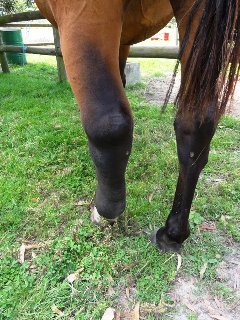Site Menu:
| This is an archived Horseadvice.com Discussion. The parent article and menus are available on the navigation menu below: |
| HorseAdvice.com » Diseases of Horses » Lameness » Leg Swellings » Leg Swelling topics not covered above » |
| Discussion on What has caused this? | |
| Author | Message |
| Member: avandia |
Posted on Sunday, Jun 19, 2011 - 11:45 pm: This horse is a rescue. This has happened twice in 3 years. Last time it took several months and she was ridden regularly before it happened. We give her antibiotics and cortisone. She does not get a temperature. She can gallop around with the other horses when it is this swollen. A real mystery. Vets have not given a known cause. |
| Member: avandia |
Posted on Tuesday, Jun 21, 2011 - 8:33 am: Please does anyone have any ideas |
| Moderator: DrO |
Posted on Tuesday, Jun 21, 2011 - 11:46 am: Hello Compassion,Without fever and lameness, and I presume the leg is not hot, this may represent a case of severe stocking up caused by lost elasticity or impaired venous or lymphatic drainage. Most cases are limited to the cannon and pastern but here the legs are swollen to the stifles. The episodic nature suggests normally drainage is adequate but trauma or mild infection overloads the system. For more on this and possible treatments see HorseAdvice.com » Diseases of Horses » Lameness » Diseases of the Lower Limb » Stocking Up: Cool Swellings of the Lower Legs. DrO |
| Member: paul303 |
Posted on Wednesday, Jun 22, 2011 - 1:31 am: Shoot, that's ugly, isn't it? I might get a tub of Antiphlogistine, slather it on, and follow the instructions on wrapping. Just make sure you wrap gently and carefully. If you've never used Antiphlogistine, google it and see if you want to try it. |
| Member: rtrotter |
Posted on Wednesday, Jun 22, 2011 - 7:39 am: Hello Compassion.Some questions? 1) Did this appear overnight or was it over several days? 2) Is this horse turned out all the time or is she in a stall for a good part of the day? 3) was she exposed to any horses that might have been given a strangles vaccine either time it happened, or was she given a strangles vaccine? I am not sure if I would poultice with any bandages as that would most likely mean confinement to a stall and her leg may blow up even more and if bandaged may cause more problems. This mare needs to move around to get the fill out of her leg as long as she is not lame. If she can be ponied to make her move I'd do that and hose with alternating warm and cold water. If the leg comes down, I'd look for any kind of cut that would mean either infection or trauma as Dr. O says, but sometimes with a leg this filled you can't find anything, until you get some of the fill out. The reason I asked about the strangles vaccine is about three years ago, I had one of my horses vaccinated for strangles, she was fine no reaction, however another horse that was turned out with her, seemingly overnight developed severe swelling in both of her back legs that similarly looked like your mare, it took several weeks to completely resolve and my vet was similarly stumped when it happened. It wasn't until sometime later that by chance I read the article here on HA on vaccine reactions that I put two and two together. She recovered, her legs still look great and she is still racing. All the best Rachelle |
| Member: babychop |
Posted on Wednesday, Jun 22, 2011 - 10:42 pm: Dr O took the words right out of my mouth, my very first thought was stocking up - the worst (and highest) I'd ever seen! Rachelle's response also sounds reasonable given her scenario though. Have you bounced both those ideas off your regular vet? Good luck! |
| Member: avandia |
Posted on Wednesday, Jun 22, 2011 - 11:29 pm: From what I have read 'stocking up' is what we call lymphangitis. I do not think it is this, as my mare is never stabled. Runs on a large acreage with other horses. She can gallop when the whole leg is swollen. Only steadies up when it is painful and causing lameness. Last time it took 11 months and then it did not return to norman size. |
| Member: avandia |
Posted on Wednesday, Jun 22, 2011 - 11:46 pm: Thinking back to when I rescued her no-one was able to tell me anything. There is a possibility she was caught in a string of straight wire for a period of time. I seem to remember a couple of marks which could have been wire. She was going to be put down. I had owned this mare previously for 5 years with no health or leg problems at all. WOULD THIS EXPLAIN WHY ONE LEG. IT TOOK SEVERAL MONTHS FOR THE SWELLING TO REDUCE. She was ridden for several months before this condition returned. |
| Moderator: DrO |
Posted on Thursday, Jun 23, 2011 - 8:46 am: No Compassion, lymphangitis is not the same as stocking up. Stocking up is a passive edema condition of the legs while lymphangitis has inflammation an a active edema process. The term lymphangitis strictly means inflammation of the lymphatics but in equine medicine is used more loosely to describe cellulitis of the legs. Important to note that if the lymphangitis is severe it may leave the horse with a chronic stocking up condition.You will find more explanation on active versus passive edema at HorseAdvice.com » Diseases of Horses » Skin Diseases, Wounds, and Swellings » Swellings / Localized Infection / Abscesses » Diagnosing and Assessing Swellings in Horses |
| Member: ajudson1 |
Posted on Thursday, Jun 23, 2011 - 10:00 am: Is it possible there is something inside those areas where you say there are scars? Was she caught up in something that remained in her skin perhaps? I have some wire that is very prickly when it's starts fraying, like thin wire with a foil like covering for lack of a better way of describing it. I could see that remaining embedded in a horse if they were caught up in it for a period of time.Maybe this time when I swelling goes down, have her sedated and like take some skin/scar samples?? Grasping at straws...maybe whatever is in there will never be found. I would be cold hosing that leg a few times a day, making her move, maybe massage too. Somethings are just never figured out. Had a gelding whose sheath swelled up and stayed that way til he died. Don't know if it bothered him or not, he died from breaking his leg. I think the swelling was there for 5 of his 7 years! Best of luck, hope it resolves itself. |
| Member: avandia |
Posted on Friday, Jun 24, 2011 - 1:13 am: Thank you all for your advice and the information. I am considering moving her to a friends place near the beach. My friend is able to do the massage etc. Does anyone have any ideas on what she could be fed. She is a poor doer. Just wondered if I should make changes to her hard feeds. Also, do you think salt water will be sufficient. Hot and cold may not be an option where she is going.
|
| Moderator: DrO |
Posted on Sunday, Jun 26, 2011 - 9:15 am: I see no reason she cannot be fed a regular horse ration. If this is stocking up I don't think the soaking is going to be as important as the massage and bandaging. I would consider experimenting with human Ace Bandages and developing techniques that allow you to bandage all the way up the leg. We give advice on this at HorseAdvice.com » Diseases of Horses » First Aid » Bandaging Horses. I think if applied with care the Ace Bandages can be applied directly to the legs but may require the use of Elastikon to keep it in place. Having an experienced leg bandager helping you will make this far more likely to be successful.DrO |
Horseadvice.com
is The Horseman's Advisor
Helping Thousands of Equestrians, Farriers, and Veterinarians Every Day
All rights reserved, © 1997 -
is The Horseman's Advisor
Helping Thousands of Equestrians, Farriers, and Veterinarians Every Day
All rights reserved, © 1997 -
